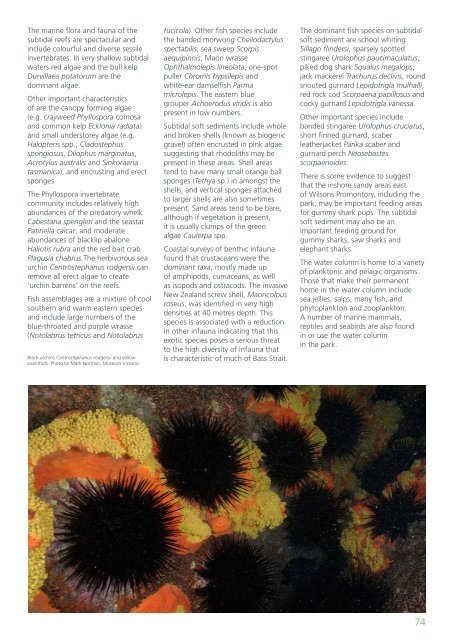Marine Natural Values Study Summary - Parks Victoria
Marine Natural Values Study Summary - Parks Victoria
Marine Natural Values Study Summary - Parks Victoria
You also want an ePaper? Increase the reach of your titles
YUMPU automatically turns print PDFs into web optimized ePapers that Google loves.
The marine flora and fauna of thesubtidal reefs are spectacular andinclude colourful and diverse sessileinvertebrates. In very shallow subtidalwaters red algae and the bull kelpDurvillaea potatorum are thedominant algae.Other important characteristicsof are the canopy forming algae(e.g. crayweed Phyllospora comosaand common kelp Ecklonia radiata)and small understorey algae (e.g.Halopteris spp., Cladostephusspongiosus, Dilophus marginatus,Acrotylus australis and Sinkoraenatasmanica), and encrusting and erectsponges.The Phyllospora invertebratecommunity includes relatively highabundances of the predatory whelkCabestana spengleri and the seastarPatiriella calcar, and moderateabundances of blacklip abaloneHaliotis rubra and the red bait crabPlagusia chabrus.The herbivorous seaurchin Centrostephanus rodgersii canremove all erect algae to create‘urchin barrens’ on the reefs.Fish assemblages are a mixture of coolsouthern and warm eastern speciesand include large numbers of theblue-throated and purple wrasse(Notolabrus tetricus and NotolabrusBlack urchins Centrostephanus rodgersii and yellowzoanthids. Photo by Mark Norman, Museum <strong>Victoria</strong>.fucicola). Other fish species includethe banded morwong Cheilodactylusspectabilis, sea sweep Scorpisaequipinnis, Maori wrasseOphthalmolepis lineolata, one-spotpuller Chromis hypsilepis andwhite-ear damselfish Parmamicrolepis. The eastern bluegrouper Achoerodus viridis is alsopresent in low numbers.Subtidal soft sediments include wholeand broken shells (known as biogenicgravel) often encrusted in pink algaesuggesting that rhodoliths may bepresent in these areas. Shell areastend to have many small orange ballsponges (Tethya sp.) in amongst theshells, and vertical sponges attachedto larger shells are also sometimespresent. Sand areas tend to be bare,although if vegetation is present,it is usually clumps of the greenalgae Caulerpa spp.Coastal surveys of benthic infaunafound that crustaceans were thedominant taxa, mostly made upof amphipods, cumaceans, as wellas isopods and ostracods. The invasiveNew Zealand screw shell, Maoricolpusroseus, was identified in very highdensities at 40 metres depth. Thisspecies is associated with a reductionin other infauna indicating that thisexotic species poses a serious threatto the high diversity of infauna thatis characteristic of much of Bass Strait.The dominant fish species on subtidalsoft sediment are school whitingSillago flindersi, sparsely spottedstingaree Urolophus paucimaculatus,piked dog shark Squalus megalops,jack mackerel Trachurus declivis, roundsnouted gurnard Lepidotrigla mulhalli,red rock cod Scorpaena papillosus andcocky gurnard Lepidotrigla vanessa.Other important species includebanded stingaree Urolophus cruciatus,short finned gurnard, scaberleatherjacket Parika scaber andgurnard perch Neosebastesscorpaenoides.There is some evidence to suggestthat the inshore sandy areas eastof Wilsons Promontory, including thepark, may be important feeding areasfor gummy shark pups. The subtidalsoft sediment may also be animportant feeding ground forgummy sharks, saw sharks andelephant sharks.The water column is home to a varietyof planktonic and pelagic organisms.Those that make their permanenthome in the water column includesea jellies, salps, many fish, andphytoplankton and zooplankton.A number of marine mammals,reptiles and seabirds are also foundin or use the water columnin the park.74
















